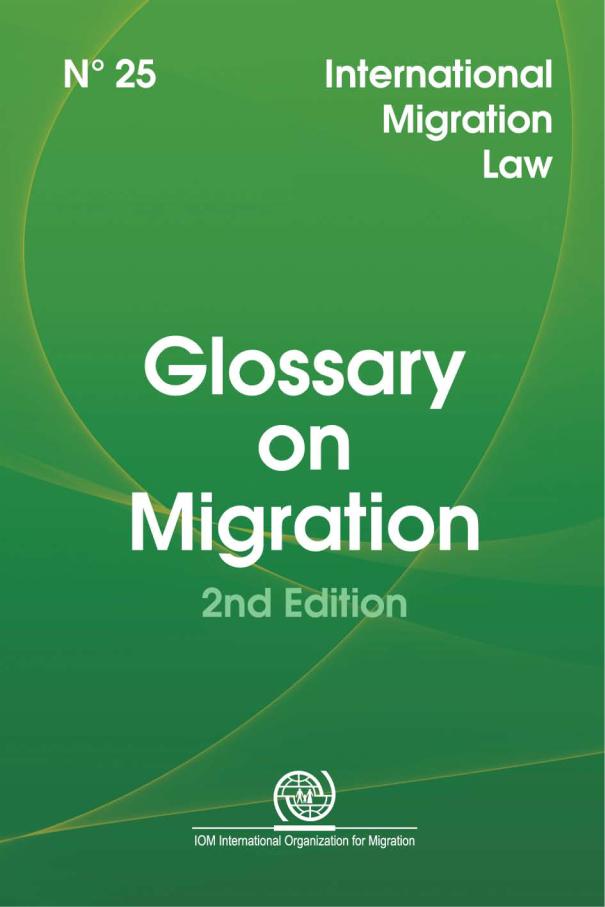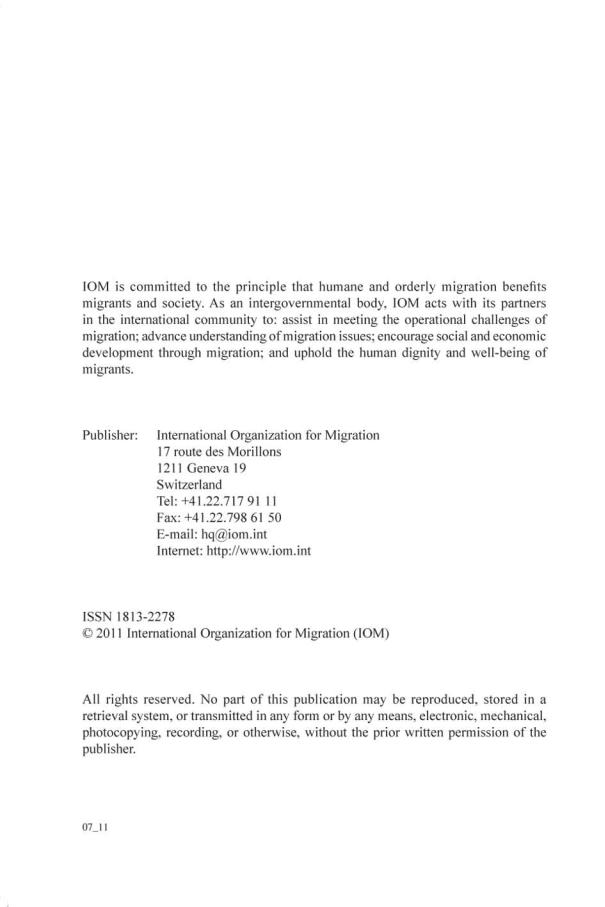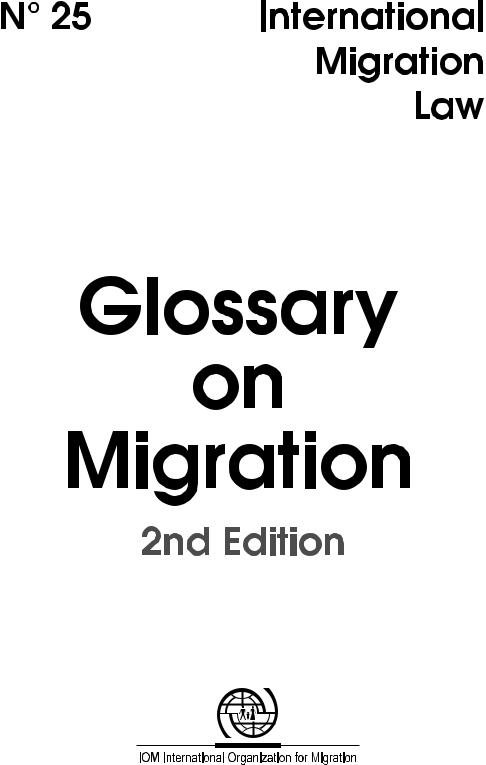
3 glossary on migration 2nd edition
.pdf


Richard Perruchoud and Jillyanne Redpath-Cross, eds.

Glossary on Migration
FOREWORD TO THE SECOND EDITION
The inaugural edition of the IOM Glossary on Migration has been widely disseminated since its publication in English in 2004 and it has now been translated into Russian, Tajik, Arabic, Spanish, Slovenian, French, Albanian, Bosnian, Chinese, Turkish, Greek, Portuguese, Italian and Macedonian.The Glossary continues to meet its objectives in being a valuable tool for practitioners, government migration officials, students and others and has been effectively utilized in regional and international fora discussing migration issues. IOM is pleased with the positive response that it has generated; it has clearly met a need and there is ongoing demand for translations into other languages.
However, even at the time of its initial publication, we recognized that it was a first attempt, withroomforimprovement,revisionsofdefinitionsandadditionsofterms.IntheForeword tothe2004edition,wealludedtothepossibilityofasubsequent,morecomplete,edition.We are pleased now to be able to introduce a second edition of the IOM Glossary on Migration whichweconsidertobemorecomprehensiveandwhichtakesintoaccountinvaluableinput from users of the glossary. Great care has been taken in revising and adding definitions and an effort has been made to streamline definitions to ensure consistency with partner organizations who have, since IOM’s publication, also issued glossaries on migration and related topics. Nevertheless, we consider the glossary to be a “living document” which will continue to need to be updated from time to time with the evolving nature of migration and, in this respect, we continue to welcome feedback from users.
It is IOM’s hope that this improved edition will continue to move the international community toward a common language when discussing migration issues. Uniformity of usage of terms serves to greatly enhance research and statistics gathering, and the exchange of information between and among States. Mutual understanding of critical terms is therefore an important first step in achieving coordinated responses to the challenges of global migration.
Asafinalpoint,acknowledgementneedstobemadeofthededicationofIOMstaffwhohave worked on this revision, and in this respect, we wish to thank our colleagues Shyla Vohra, Paola Pace, Cara Wulf, Anna Lillicrap and Ryszard Cholewinski for their contributions to this important work.
Richard Perruchoud
Jillyanne Redpath-Cross
Editors
3

Glossary on Migration
FOREWORD TO THE FIRST EDITION
Migration is increasingly being acknowledged as an issue that needs a global approach and coordinated responses. States are not only discussing migration issues at the bilateral level, but also regionally and lately in global arenas.Acommonly understood language is indispensable for such coordination and international cooperation to be successful. This glossaryattemptstoserveasaguidetothemireoftermsandconceptsinthemigrationfield, in an effort to provide a useful tool to the furtherance of such international cooperation.
This glossary has been some time in the making. Informal drafts were prepared by IOM in the seventies and used by its staff. A renewed attempt to a consolidation was made in the late eighties by IOM technical cooperation centre in Vienna and its output was published in 2001 in the “Migration Handbook” edited by P. J. Van Krieken. In the context of IOM’s recent initiative to strengthen and enhance its involvement in the field of international migration law, the decision was taken to produce this glossary and to consolidate into one definitive text the terminology used in the migration field in order to provide a reliable referenceforpractitioners,governmentmigrationofficials,studentsandothers. Thepresent product cannot be said to be exhaustive and any comments or suggestions for an eventual second, and more complete, edition will be welcome.
When compiling the glossary, it became quickly apparent that definitions in this field are often vague, controversial or contradictory. There is an absence of universally accepted definitions, which stems partially from the fact that migration is something which has traditionally only been addressed at the national level; the result is that the usage of migration terms varies from country to country. Further, even within a country, terms can vary as to the meaning or implication. Definitions – and this is true of all terminology, not only that related to migration – may vary according to a given perspective or approach. Migration is of concern to a number of bodies, including governments of both sending and receiving countries, police and border authorities, governmental and non-governmental organizations, migrants themselves. Where there are no universally accepted definitions, the potential exists for each group to decide, formally or informally, on its own definition, according to its perspective. By way of example there was a wide array of definitions for the term “trafficking”, which have only recently been consolidated with a definition being provided in a formal treaty at the international level; many other terms have not yet been internationally agreed upon. Within this glossary, care has been taken to provide the international definition where it exists; in other cases, a general definition is provided and mention made of alternative definitions.
Another challenge faced in this compilation was the variety of terms used to describe the same or similar phenomenon. For example, there may be nuances between the terms “illegal migration”, “clandestine migration”, “undocumented migration” and “irregular migration”; however, to a large extent they are used loosely and often interchangeably. To this end, some cross-referencing of terms has been inevitable in order to guide the reader to alternative or interchangeable terms.
5

International Migration Law
Last but not least, I wish to express my gratitude and appreciation to ShylaVohra, Jillyanne Redpath and KatarinaTomolova, my colleagues in Legal Services, who contributed to this endeavour and made it happen: their competence, smiling dedication and untiring efforts were instrumental in bringing the glossary to life.
Richard Perruchoud
Editor
6
|
Glossary on Migration |
|
|
|
A |
abduction |
Theactofleadingsomeoneawaybyforceorfraudulent |
|
persuasion. When used in relation to child abduction, |
|
this term means the removal or retention of a child in |
|
breach of custody rights. |
|
See also child exploitation, kidnapping, trafficking |
absconding |
The action by which a person seeks to avoid legal |
|
proceedings by not surrendering to the custody of a |
|
court. |
accession |
““Ratification”, “acceptance”, “approval”, and |
|
“accession” mean in each case the international act so |
|
named whereby a State establishes on the international |
|
plane its consent to be bound by a treaty” (Art.2(1)(b), |
|
Vienna Convention on the Law of Treaties, 1969). |
|
See also ratification, reservation to a treaty, treaty |
accommodation centre |
See holding centre |
accord |
In a general sense, a meeting of the minds. In public |
|
international law, it is a term used synonymously with |
|
treaty or convention. |
|
Seealsoagreement,convention,covenant,instrument, |
|
treaty |
accredited State |
State which receives a diplomatic agent. |
|
See also accrediting State |
accrediting State |
State which sends a diplomatic agent. |
|
See also accredited State |
acculturation |
A series of changes in cultural mores (ideas, words, |
|
values, norms, behaviour, institutions) resulting |
|
from direct and continuous contact between groups |
|
of different cultures, particularly through migratory |
|
movements or economic exchanges.Acculturation can |
|
occur when one group adopts the traits of the dominant |
|
culture of a society in public life while keeping its |
|
own culture in the private sphere. Acculturation may |
|
also result in the creation of a new culture, one that |
|
synthesizes elements of the two original cultures. |
|
See also assimilation, culture, integration |
7

International Migration Law
acquisition of nationality |
Obtaining the nationality of a State by a person who |
|
is a non-national by birth, whether on the person’s |
|
application,followingfromachangeinpersonalstatus, |
|
or as the result of the ceding of territory from one State |
|
to another. |
|
See also denationalization, loss of nationality, |
|
nationality |
adjudication |
In the migration context, a decision as to whether an |
|
applicant is qualified for the visa, refugee status, or |
|
other immigration status he or she seeks. |
adjudicator |
Inthemigrationcontext,anindividualwhoisauthorized |
|
by law to make decisions as to whether an applicant |
|
is qualified for the visa, refugee status, or other |
|
immigration status he or she seeks. |
|
See also interview |
adjustment of status |
See change of status |
administrative detention |
Ameasuretodepriveapersonofhisorherlibertytaken |
|
by the competent administrative authority of a State. |
|
Legislation in many countries foresees the placement |
|
in administrative detention of migrants in an irregular |
|
situation, either on their arrival in the territory, or with |
|
a view to their expulsion. |
|
See also detention, migrant in an irregular situation |
admission |
The granting of entry into a State. A non-national |
|
has been ‘admitted’ if he or she passed through a |
|
checkpoint (air, land or sea) and is permitted to enter |
|
by border officials. A non-national who has entered |
|
clandestinely is not considered to have been admitted. |
|
See also border officials, checkpoint, entry, non- |
|
admission |
adoption |
The statutory process of terminating legal rights and |
|
duties between the child and the natural parents, and |
|
substituting similar rights and duties between the child |
|
and the adoptive parents. |
|
In public international law, the term is used to refer to |
|
the formal act by which negotiating parties establish |
|
the form and content of a treaty. The treaty is adopted |
|
through a specific act expressing the will of the States |
|
and the international organizations participating in |
|
the negotiation of that treaty, e.g., by voting on the |
|
text, initialling, signing, etc.Adoption may also be the |
8
